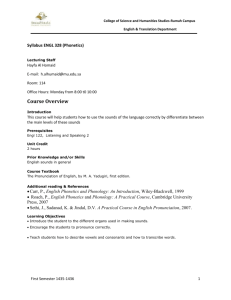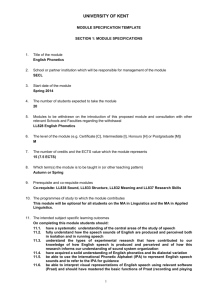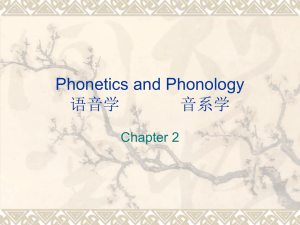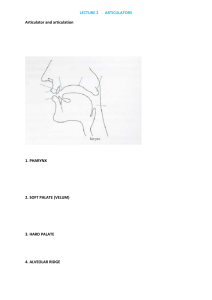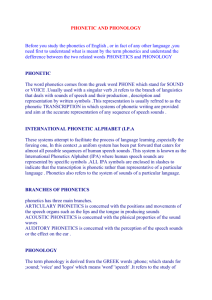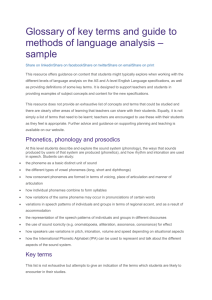Chapter 2 Speech Sounds
advertisement
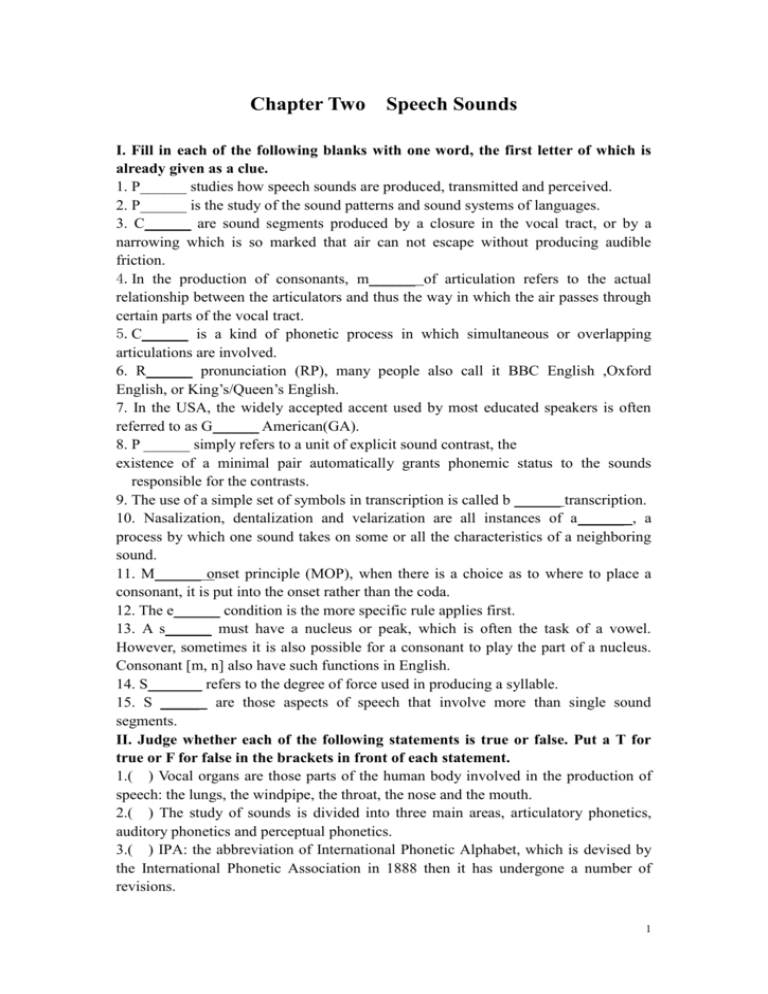
Chapter Two Speech Sounds I. Fill in each of the following blanks with one word, the first letter of which is already given as a clue. 1. P______ studies how speech sounds are produced, transmitted and perceived. 2. P______ is the study of the sound patterns and sound systems of languages. 3. C______ are sound segments produced by a closure in the vocal tract, or by a narrowing which is so marked that air can not escape without producing audible friction. 4.In the production of consonants, m______ of articulation refers to the actual relationship between the articulators and thus the way in which the air passes through certain parts of the vocal tract. 5.C______ is a kind of phonetic process in which simultaneous or overlapping articulations are involved. 6. R______ pronunciation (RP), many people also call it BBC English ,Oxford English, or King’s/Queen’s English. 7. In the USA, the widely accepted accent used by most educated speakers is often referred to as G______ American(GA). 8. P ______ simply refers to a unit of explicit sound contrast, the existence of a minimal pair automatically grants phonemic status to the sounds responsible for the contrasts. 9. The use of a simple set of symbols in transcription is called b ______ transcription. 10. Nasalization, dentalization and velarization are all instances of a______ , a process by which one sound takes on some or all the characteristics of a neighboring sound. 11. M______ onset principle (MOP), when there is a choice as to where to place a consonant, it is put into the onset rather than the coda. 12. The e______ condition is the more specific rule applies first. 13. A s______ must have a nucleus or peak, which is often the task of a vowel. However, sometimes it is also possible for a consonant to play the part of a nucleus. Consonant [m, n] also have such functions in English. 14. S_______ refers to the degree of force used in producing a syllable. 15. S _____ are those aspects of speech that involve more than single sound segments. II. Judge whether each of the following statements is true or false. Put a T for true or F for false in the brackets in front of each statement. 1.( ) Vocal organs are those parts of the human body involved in the production of speech: the lungs, the windpipe, the throat, the nose and the mouth. 2.( ) The study of sounds is divided into three main areas, articulatory phonetics, auditory phonetics and perceptual phonetics. 3.( ) IPA: the abbreviation of International Phonetic Alphabet, which is devised by the International Phonetic Association in 1888 then it has undergone a number of revisions. 1 4.( ) The use of more specific symbols to show more phonetic detail is referred to as broad transcription. 5.( ) In the production of consonants, place of articulation refers to where in the vocal tract there is approximation, narrowing, or the obstruction of air. 6.( )Vowels are sound segments produced by a closure in the vocal tract, or by a narrowing which is so marked that air can not escape without producing audible friction. 7. ( ) The distinction between vowels and consonants lies in the obstruction of airstream. 8.( ) phonological analysis relies on the principle that certain sounds cause changes in the meaning of a word or phase, whereas other sounds do not. A simple methodology to demonstrate this is to take a word, replace one sound by another, and see whether a different meaning results. This technique, called the maximum pairs test, can be used to find out which sound substitutions cause differences of meaning. 9.( ) Distinctive features was first developed by Roman Jacobson in the 1940s as a means of working out a set of phonological contrasts or oppositions to capture particular aspects of language sounds 10. ( ) A syllable must have a nucleus or peak, which must be the task of a vowel. 11. ( ) The principle suprasegmental features are syllable, stress, tone, and intonation. 12.( ) In general situations, notional words are normally unstressed while structural words are stressed. 13.( ) In Chinese tone changes are used in a different way, affecting the meanings of individual words. 14.( ) The regular past tense form in English is pronounced as [d] when the word ends with a voiceless consonant, [t] when it ends with a voiced sound, and [id] when it ends with [t] or [d]. 15. ( ) Intonation involves the occurrence of recurring fall-rise patterns, each of which is used with a set of relatively consistent meanings, either on single words or on groups of varying length. III. Give the description of the following sound segments in English. 1) [t] 2) [k] 3) [l] 4) [h] 5) [e] IV. Give the IPA symbols for the sounds that correspond to the descriptions below. 1) voiced alveolar stop 2) voiceless labiodental fricative 3) palatal approximant 4) voiceless bilabial stop 5) high front lax unrounded vowel V. Define the following terms. 2 phonetics speech organs phonology articulatory phonetics speech organs voicing International Phonetic Alphabet consonant manner of articulation place of articulation vowel Cardinal Vowels Coarticulation semi-vowel minimal pairs test phoneme allophone assimilation Elsewhere Condition distinctive features Maximal Onset Principle syllable stress intonation VI. What are basic requirements of the description of English vowels? VII. How do phonetics and phonology differ? Key to supplementary exercises I. Fill in each of the following blanks with one word, the first letter of which is already given as a clue. 1. Phonetics 2. Phonology 3. Consonants 4.manner 5.Coarticulation 6. Received 7. General 8. Phoneme 9. broad 10. assimilation 11. Maximal 12. elsewhere 13. syllable 14. Stress 15. Suprasegmental II. Judge whether each of the following statements is true or false. Put a T for true or F for false in the brackets in front of each statement. 1. T 2. F 3. T 4. F 5. T 6. F 7. T 8. F 9. T 10. F 11. T 12. F 13. T 14. F 15. T III. Give the description of the following sound segments in English. 1) [t] 2) [k] 3) [l] 4) [h] 5) [e] IV. Give the IPA symbols for the sounds that correspond to the descriptions below. 1) voiced alveolar stop 3 2) voiceless labiodental fricative 3) palatal approximant 4) voiceless bilabial stop 5) high front lax unrounded vowel V. Define the following terms.(answer omitted) VI. The description of English vowels needs to fulfill four basic requirements: 1) The height of tongue raising (high, mid, low); 2) The position of the highest part of the tongue (front, central,back); 3) The length of tenseness of the vowel (tense vs. lax or long vs. short); 4) Lip-rounding (rounded vs. unrounded). VII. Both phonetics and phonology study human speech sounds but they differ in their focus. Phonetics is the study of how speech sounds are produced, transmitted and perceived. The study of sounds is divided into three main areas, articulatory phonetics, acoustic phonetics and perceptual or auditory phonetics. Phonology is the study of the sound patterns and sound systems of languages. It aims to discover the principles that govern the way sounds are organized in languages, and to explain the variations that occur. In phonology we normally begin by analyzing an individual language,say English, in order to determine its phonological structure, i.e. which sound units are used and how they are put together. Then we compare the properties of sound systems in different languages in order to make hypotheses about the rules that underline the use of sounds in them, and ultimately we aim to discover the rules that underline the sound patterns of all languages. 4
